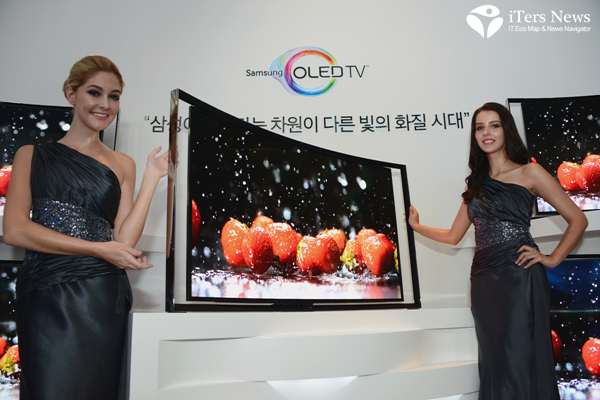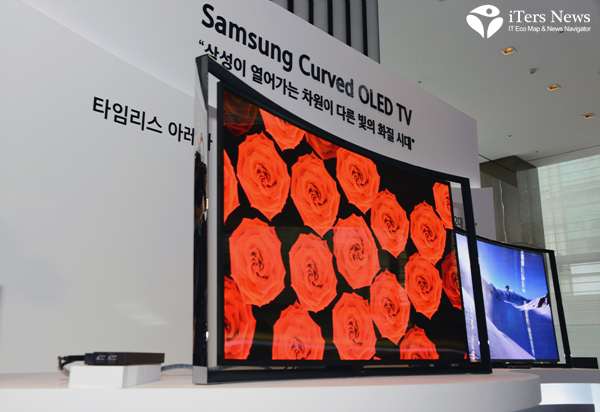True RGB color 55-inch OLED TVs hit shelves, but still expensive luxury
(iTers News) – Samsung Electronics starts to sell a 55-inch curved full-HD OLED TV effective from today across the world in what it said is the world’s first true RGB OLED TV of that size.
The commercial roll-out represents its catch-up drive to reverse backyard rival LG Electronics’ lead in the release of OLED TVs, which began to fetch in early January.
Unlike LG’s WRGB color scheme that embeds a separate color filter sheet of red, green and blue colors on top of a matrix of white OLED cells, Samsung’s 55-inch OLED TV panel incorporates a grid of self-illuminating RGB cells.
As each RGB cell is shedding lights of RGB colors, it comes with no color filter.
The technology breakthrough translates into more vivid color representation, limitless viewing angel, and speedier pixel switching. In theory, for example, it can switch pixels 100 times faster than LG’s WRGB color coordination scheme can afford to do.
At a press conference here held in Seoul, Kim Hyun Sub, executive vice president and head of Samsung visual image division said,”We are more focusing on picture quality, so we have worked hard to ensure every OLED cells work perfectly. ”
He also said Samsung has no plan to ship wall-type OLED TVs
When asked about what type of cell fabrication technology was used to deposit RGB cells, he didn’t give much of details, but he briefly said he knows some variations of FMM, or fine metal mask evaporation technology were used.
From Cluster to In-line 
Samsung Display is now using the cluster type of FMM equipment to fabricate small OLED display, but when it comes to 10-inch and larger OLED displays, it is extremely challenging to perfectly align, pattern, deposit, encapsulate more than 2 million pixels through the masks in a glass substrate as large as 670mmx730mm
As well, it costs dearly, as it requires lots of expensive fine metal masks and processing layers. 
To manufacture the 55-inch curved full HD panel, Samsung Display seems to adopt in-line type of FMM methodology
Samsung said that all 2 million pixels of the full HD 55-inch OLED TV are perfectly working in what the company said is ‘zero pixel defect’ patterning.
Neither does he give the exact yield figure. As the yield is the ratio of marketable items versus total production, it has something to do with manufacturing costs and eventually retail price.
Samsung’s 55-inch curved OLED will sell for 15 million won, or approximately US$12,000. The exorbitantly premium price implies that the yield is still very low, and will take a long while before it reaches economies of scale.
True enough, OLED TVs are still expensive luxury, because there are many unsolved technological challenges. The toughest one is about how to pattern , deposit, and encapsulate OLED cells on a large glass substrate without compromising uniformity. The encapsulation process is essential, because it needs to protect humidity-susceptible OLED cells from moisture.
Panasonic of Japan came up with a prototype 555-inch full-HD RGB OLED using a roll-to-roll printing technology to deposit OLED cells.
